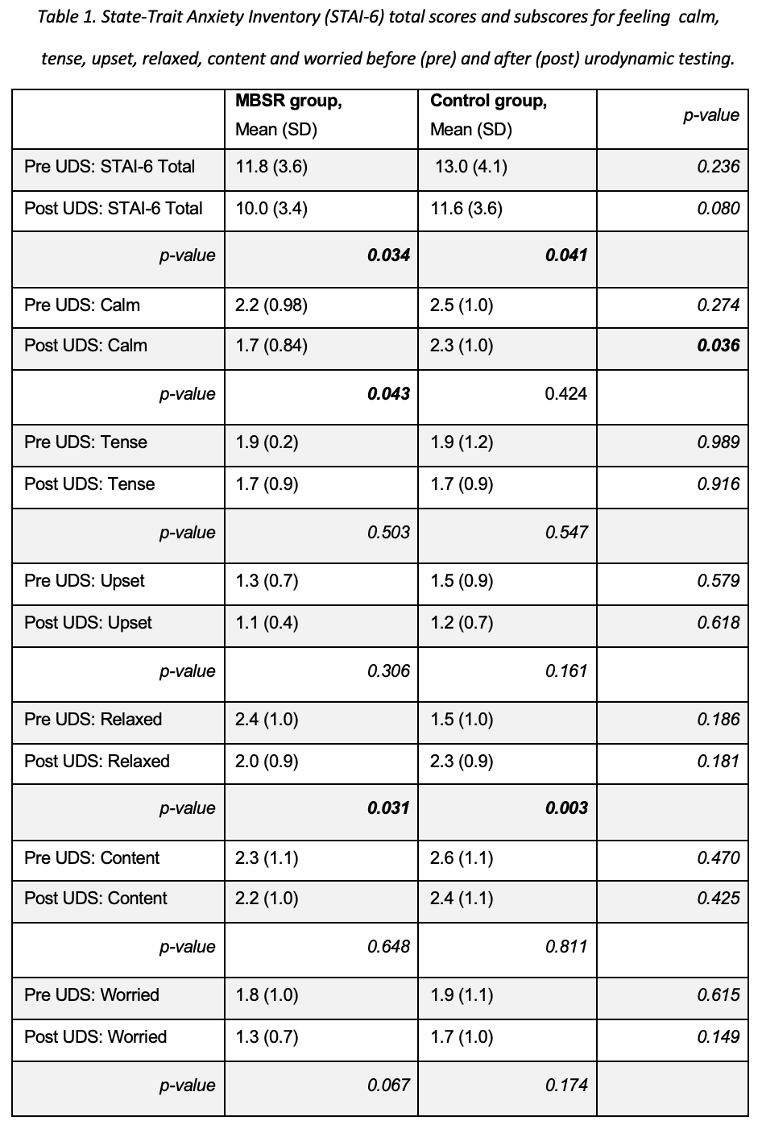Back
Poster, Podium & Video Sessions
Podium
PD06: Urodynamics/Lower Urinary Tract Dysfunction/Female Pelvic Medicine: Female Incontinence: Therapy I
PD06-03: Mindfulness based-stress reduction is associated with decreased levels of patients&[prime] anxiety after urodynamics - a prospective randomized controlled trial
Friday, May 13, 2022
9:50 AM – 10:00 AM
Location: Room 255
Ruby Kuang*, Sydney Drury, Akin Amasyali, Hillary Wagner, Forrest Jellison, Andrea Staack, Loma Linda, CA
- RK
Podium Presenter(s)
Introduction: Urodynamics (UDS) assesses lower urinary tract symptoms (LUTS). UDS is invasive, requiring intravesical, vaginal or rectal catheters. Prior studies show that patients may experience anxiety and pain. We aimed to investigate the effect of mindfulness-based stress reduction protocol (MBSR) on patients’ anxiety and pain during UDS.
Methods: A randomized controlled trial was performed on patients who underwent UDS from November 2020 to July 2021. All patients (n=60) were randomized into MBSR (n=30) and control groups (n=30). Exclusion criteria were age less than 18 years, bacteriuria, incarceration, pregnancy, non-English speakers, or patients with insensate bladders.
Prior to UDS, all patients received standardized UDS education, completed validated questionnaires assessing LUTS (Urogenital Distress Inventory 6, UDI-6), anxiety (State-Trait Anxiety Inventory 6, STAI-6), and pain (Visual Analog Scale, VAS). The MBSR group listened to a mindfulness audio prompt prior to UDS. UDS testing was performed in a quiet setting. After testing, all patients completed STAI-6, Likert scale, VAS surveys, and a validated UDS-perception questionnaire. Paired t-test, independent t-test, and Chi-squared tests were used for analysis. A p-value of =0.05 was considered statistically significant.
Results: Both groups were similar in demographics, including mean age (MBSR: 61.9 years, control: 58.5 years) and UDI-6 scores (MBSR: 9.5, control: 11.2). After UDS, total STAI-6 scores and overall anxiety improved in both groups (MBSR: p=0.034, control: p=0.041). In the MBSR group, STAI-6 subscores for calmness (p=0.043) and relaxation (p=0.031) improved after UDS, however in the control group, the STAI-6 subscores for relaxation worsened (p=0.003) after UDS. There was no difference in pain and patient satisfaction scores between both groups, before or after UDS.
The table below conveys the significantly decreased STAI-6 subscores in the MBSR group after UDS.
Conclusions: The utilization of MBSR protocol can improve anxiety and specifically the sensations of calmness and relaxation during UDS testing.
Source of Funding: N/A

Methods: A randomized controlled trial was performed on patients who underwent UDS from November 2020 to July 2021. All patients (n=60) were randomized into MBSR (n=30) and control groups (n=30). Exclusion criteria were age less than 18 years, bacteriuria, incarceration, pregnancy, non-English speakers, or patients with insensate bladders.
Prior to UDS, all patients received standardized UDS education, completed validated questionnaires assessing LUTS (Urogenital Distress Inventory 6, UDI-6), anxiety (State-Trait Anxiety Inventory 6, STAI-6), and pain (Visual Analog Scale, VAS). The MBSR group listened to a mindfulness audio prompt prior to UDS. UDS testing was performed in a quiet setting. After testing, all patients completed STAI-6, Likert scale, VAS surveys, and a validated UDS-perception questionnaire. Paired t-test, independent t-test, and Chi-squared tests were used for analysis. A p-value of =0.05 was considered statistically significant.
Results: Both groups were similar in demographics, including mean age (MBSR: 61.9 years, control: 58.5 years) and UDI-6 scores (MBSR: 9.5, control: 11.2). After UDS, total STAI-6 scores and overall anxiety improved in both groups (MBSR: p=0.034, control: p=0.041). In the MBSR group, STAI-6 subscores for calmness (p=0.043) and relaxation (p=0.031) improved after UDS, however in the control group, the STAI-6 subscores for relaxation worsened (p=0.003) after UDS. There was no difference in pain and patient satisfaction scores between both groups, before or after UDS.
The table below conveys the significantly decreased STAI-6 subscores in the MBSR group after UDS.
Conclusions: The utilization of MBSR protocol can improve anxiety and specifically the sensations of calmness and relaxation during UDS testing.
Source of Funding: N/A


.jpg)
.jpg)